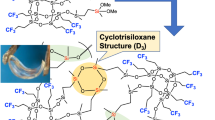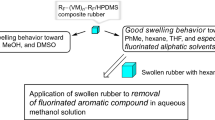Abstract
A high heat-resistant hydroxyl boron–silicone vinylidene oil (HBSVO) was synthesized by copolymerizing hydroxyl polyborosiloxane oil (HPBSO) prepolymer with fumaryl chloride. The temperature at 5% mass loss (T5), 10% mass loss (T10), and maximum decomposition rate (Tmax) of HBSVO was 515, 550, and 600 °C, respectively. The structure –Si–O–B–O–C(=O)–CH=CH–C(=O)– in the backbone of HBSVO might cause a tendency to form a five-member ring structure by hyperconjugation action between boron atom and vinylidene groups. The hyperconjugation action, which improved the heat-resistant and hydrolysis-resistant properties of HBSVO, was confirmed by UV spectroscopy, 11B-NMR, and 1H-NMR. The chemical moieties (–Si–O–B–O–C(=O)–CH=CH–C(=O)–) were also identified by Fourier transform infrared (FT-IR) and 29Si-NMR (CDCl3) spectroscopies.











Similar content being viewed by others
References
Partenhauser A, Zupančič O, Podričnik S, Rohrer J, Leichner C, Andreas BS. Entirely S-protected silicone oil as second generation mucoadhesive agent. Eur Polym J. 2016;76:53–62.
Grassie N, Francey KF, Macfarlane IG. The thermal degradation of polysiloxanes—part 4: Poly(dimethyl/diphenyl siloxane). Polym Degrad Stab. 1980;2:67–83.
Wang Z, Li H, Zheng J. TG–MS study on the effect of multi-walled carbon nanotubes and nano-Fe2O3 on thermo-oxidative stability of silicone rubber. J Therm Anal Calorim. 2016;126:733–42.
Kemaloglu S, Ozkoc G, Aytac A. Properties of thermally conductive micro and nano size boron nitride reinforced silicon rubber composites. Thermochim Acta. 2010;499:40–7.
Ji T, Zhang LQ, Wang WC, Liu Y, Zhang XF, Yong LL. Cold plasma modification of boron nitride fillers and its effect on the thermal conductivity of silicone rubber/boron nitride composites. Polym Compos. 2012;33:1473–81.
Zhou WY, Qi SH, Zhao HZ, Liu NL. Thermally conductive silicone rubber reinforced with boron nitride particle. Polym Compos. 2007;28:23–8.
Gao BZ, Xu JZ, Peng JJ, Kang FY, Du HD, Li J, Chiang SW, Xu CJ, Hu N, Ning XS. Experimental and theoretical studies of effective thermal conductivity of composites made of silicone rubber and Al2O3 particles. Thermochim Acta. 2015;614:1–8.
Girish D, Mary ER. The effect of phenyl content on the degradation of poly(dimethyl diphenyl) siloxane copolymers. Polym Degrad Stab. 2001;74:363–70.
Ren Z, Xie P, Jiang S, Yan S, Zhang R. Study of the supramolecular architecture-directed synthesis of a well-defined triple-chain ladder polyphenylsiloxane. Macromol. 2010;43:2130–6.
Brus J, Kolář F, Machovič V, SvíTilová J . Structure of silicon oxycarbide glasses derived from poly(methylsiloxane) and poly[methyl(phenyl)siloxane] precursors. J Non-Cryst Solids. 2001;289:62–74.
Drake K, Mukherjee I, Mirza K, Ji HF, Wei Y. Phenylethynyl and phenol end-capping studies of polybiphenyloxydiphenylsilanes for cross-linking and enhanced thermal stability. Macromolecules. 2011;44:4107–15.
Madsen FB, Dimitrov I, Anders ED, Søren H, Anne LS. Novel cross-linkers for PDMS networks for controlled and well distributed grafting of functionalities by click chemistry. Polym Chem. 2013;4:1700–7.
Ulrich L, Kantor SW, Schmidtrohr AK, Macknight WJ. Vinyl-substituted silphenylene siloxane copolymers: novel high-temperature elastomers. Macromolecules. 1999;32:3426–31.
Mera G, Riedel R, Poli F, Müller K. Carbon-rich SiCN ceramics derived from phenyl-containing poly(silylcarbodiimides). J Eur Ceram Soc. 2009;29:2873–83.
Chruściel JJ, Janowska G, Fejdyś M. Thermal properties of polymethylvinylborosiloxanes. J Therm Anal Calorim. 2012;109:1049–58.
Puneet P, Vedarajan R, Matsumi N. Alternating poly(borosiloxane) for solid state ultrasensitivity toward fluoride ions in aqueous media. ACS Sens. 2016;1:1198–202.
Viard A, Fonblanc D, Schmidt M, Lale A, Salameh C, Soleihavoup A, Mélanie W, Champagne P, Cerneaux S, Babonneau F, Chollon G, Rossignol F, Gervais C, Bernard S. Molecular chemistry and engineering of boron-modified polyorganosilazanes as new processable and functional SiBCN precursors. Chem Eur J. 2017;23:1–16.
Zhou W, Yang H, Guo X, Lu J. Thermal degradation behaviors of some branched and linear polysiloxanes. Polym Degrad Stab. 2006;91:1471–5.
Liu Z, Picken SJ, Besseling NAM. Polyborosiloxanes (PBSs), synthetic kinetics, and characterization. Macromolecules. 2014;47:4531–7.
Mormann W, Wagner T. Acylation of (partially) silylated poly(vinyl alcohol)s with acyl chlorides. Vinyl chloride/vinyl ester copolymers by polymer analogous reaction. Macromol Chem Phys. 1996;197:3463–71.
Nixon AC, Branch GEK. The rates of alcoholyses of triarylmethyl chlorides. J Am Chem Soc. 1936;58:492–8.
Gencer A, Oksal BS. Synthesis and characterization of novel SiBOC ceramics: comparison of microwave and ultrasonic application on gelation time. J Sol-Gel Sci Technol. 2015;73:171–80.
Merten R. Synthesis of heterocyclic ring systems for heat-resistant plastics from polyisocyanates. Angew Chem Int Edit. 1971;10:294–301.
Mousurkal R, Kirby R, Muller WS, Soares WJ, Kumar J. Simple green synthesis of polyborosiloxanes as environmentally-safe, non-halogenated flame retardant polymers. Green Chem. 2011;13:659–65.
Brown WG, Reagan H. Steric effects in the ultraviolet absorption spectra of aromatic nitro compounds. J Am Chem Soc. 1947;69:1032–3.
Christopher PM, Tully TJ. Some octet and bond refractivities involving boron. J Am Chem Soc. 1958;80:6516–9.
Straub DK. Lewis structures of boron compounds involving multiple bonding. J Chem Edu. 1995;72:494.
Vicente AI, Pereira SG, Nunes TG, Ribeiro MR. 1H-NMR study of maleic anhydride modified ethylene-diene copolymers. J Polym Res. 2011;18:527–32.
Li XJ, Fu WG, Wang YN, Chen TH, Liu XH, Lin H, Sun PC, Jin QH, Ding DT. Dynamics of liquid crystalline phases in block copolymers studied by 2H-NMR spectroscopy. Polymer. 2008;49:2886–97.
Lippincott ER, Vanvalkenburg A, Weir CE, Bunting EN. Infrared studies on polymorphs of silicon dioxide and germanium dioxide. J Res Nat Bureau Stand. 1958;61(1):61–70.
Blanco I, Abate L, Bottino FA, Bottino P. Synthesis, characterization and thermal stability of new dumbbell-shaped isobutyl-substituted POSSs linked by aromatic bridges. J Therm Anal Calorim. 2014;117(1):243–50.
Chen T, Shao MW, Xu HY, Zhuo SJ, Liu SS, Lee ST. Molecularly imprinted polymer-coated silicon nanowires for protein specific recognition and fast separation. J Mater Chem. 2012;22(9):3990–6.
Piao JC, Katori S, Kawaharamura T, Li CY, Fujita S. Fabrication of silicon oxide thin films by mist chemical vapor deposition method from polysilazane and ozone as sources. Jpn J Appl Phys. 2012;51(9):090201.
Popescu MC, Gómez R, Mata FJDL, Rasines B, Simionescu BC. Characterization by Fourier transform infrared spectroscopy (FT-IR) and 2D IR correlation spectroscopy of a carbosilane dendrimer with peripheral ammonium groups. J Nanopart Res. 2013;15(6):1713.
Ismail H, Shaari SM. Curing characteristics, tensile properties and morphology of palm ash/halloysite nanotubes/ethylene-propylene-diene monomer (EPDM) hybrid composites. Polym Test. 2010;29(7):872–8.
Yokoyama Y, Tanioka A, Miyasaka K. Preparation of a single bipolar membrane by plasma induced graft polymerization. J Membr Sci. 1989;43(2–3):165–75.
Acknowledgements
The authors acknowledge financial support from the Fundamental Research Funds for the Central Universities (JD2016JGPY0002) and the funds of Hefei Research Institute (IMICZ2015103).
Author information
Authors and Affiliations
Corresponding author
Rights and permissions
About this article
Cite this article
Zhou, Z., Shen, H., Ren, F. et al. An outstanding heat-resistant hydroxyl boron–silicone oil with hyperconjugation action in backbone. J Therm Anal Calorim 132, 1825–1831 (2018). https://doi.org/10.1007/s10973-018-7065-6
Received:
Accepted:
Published:
Issue Date:
DOI: https://doi.org/10.1007/s10973-018-7065-6




